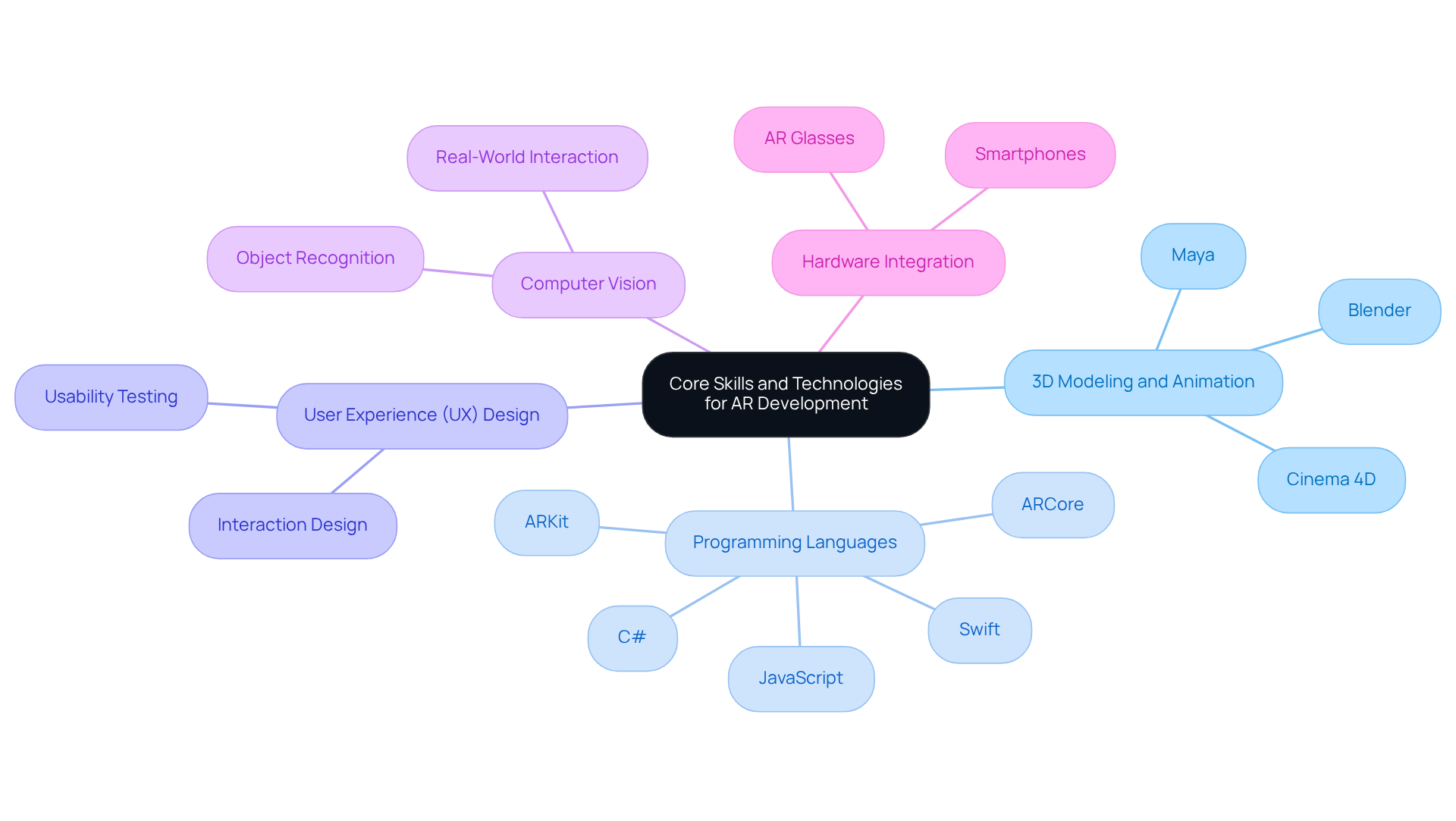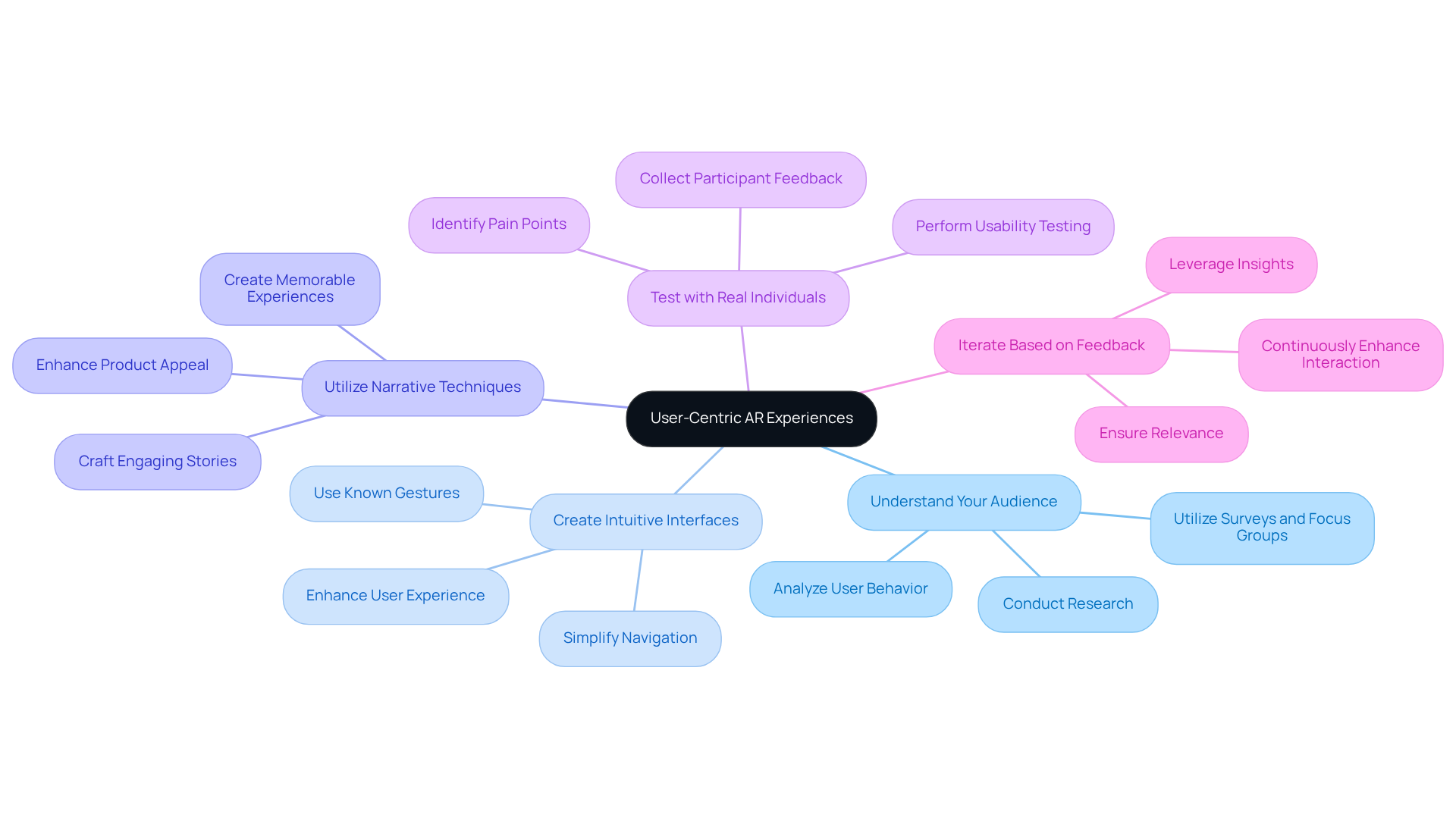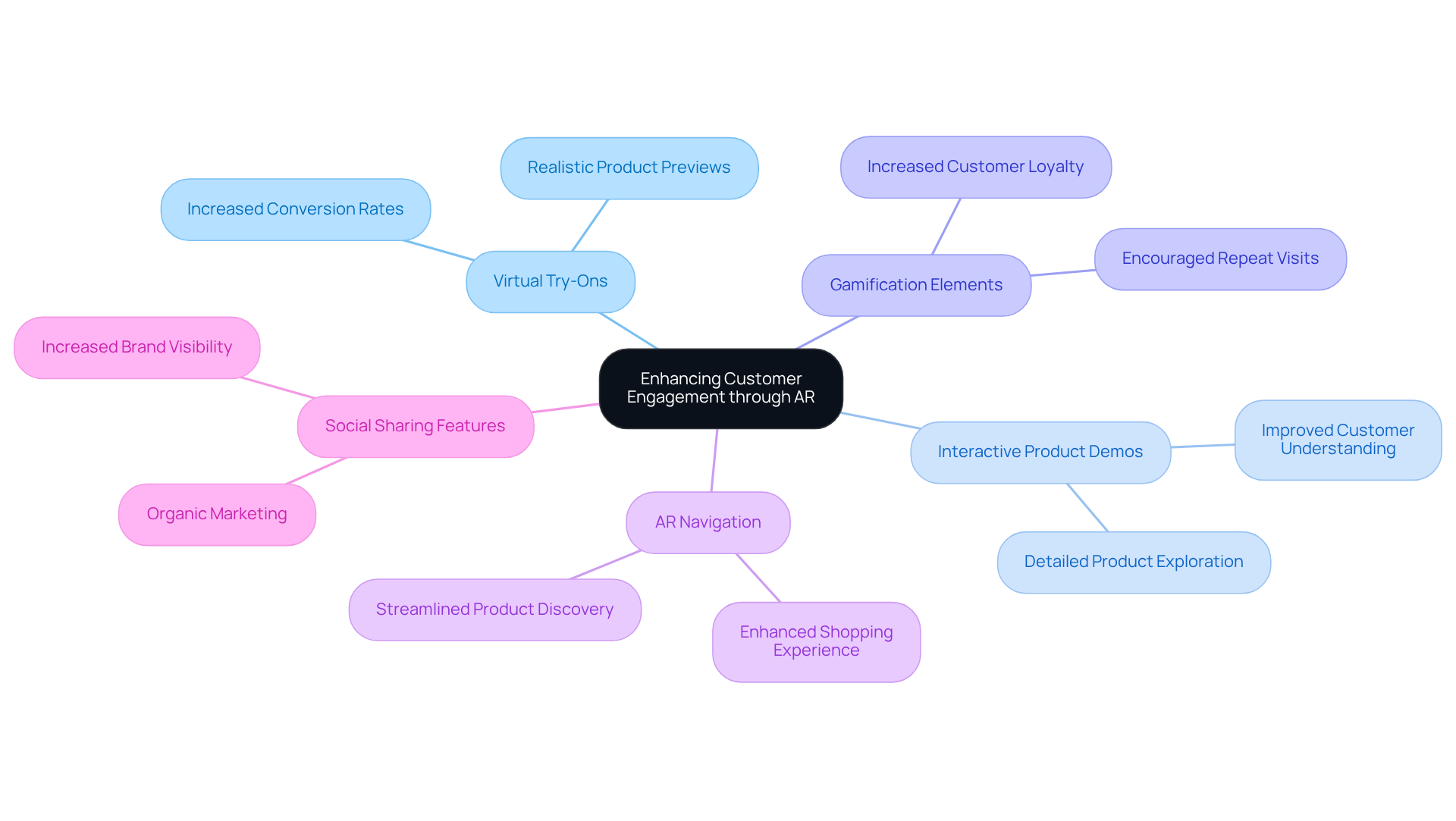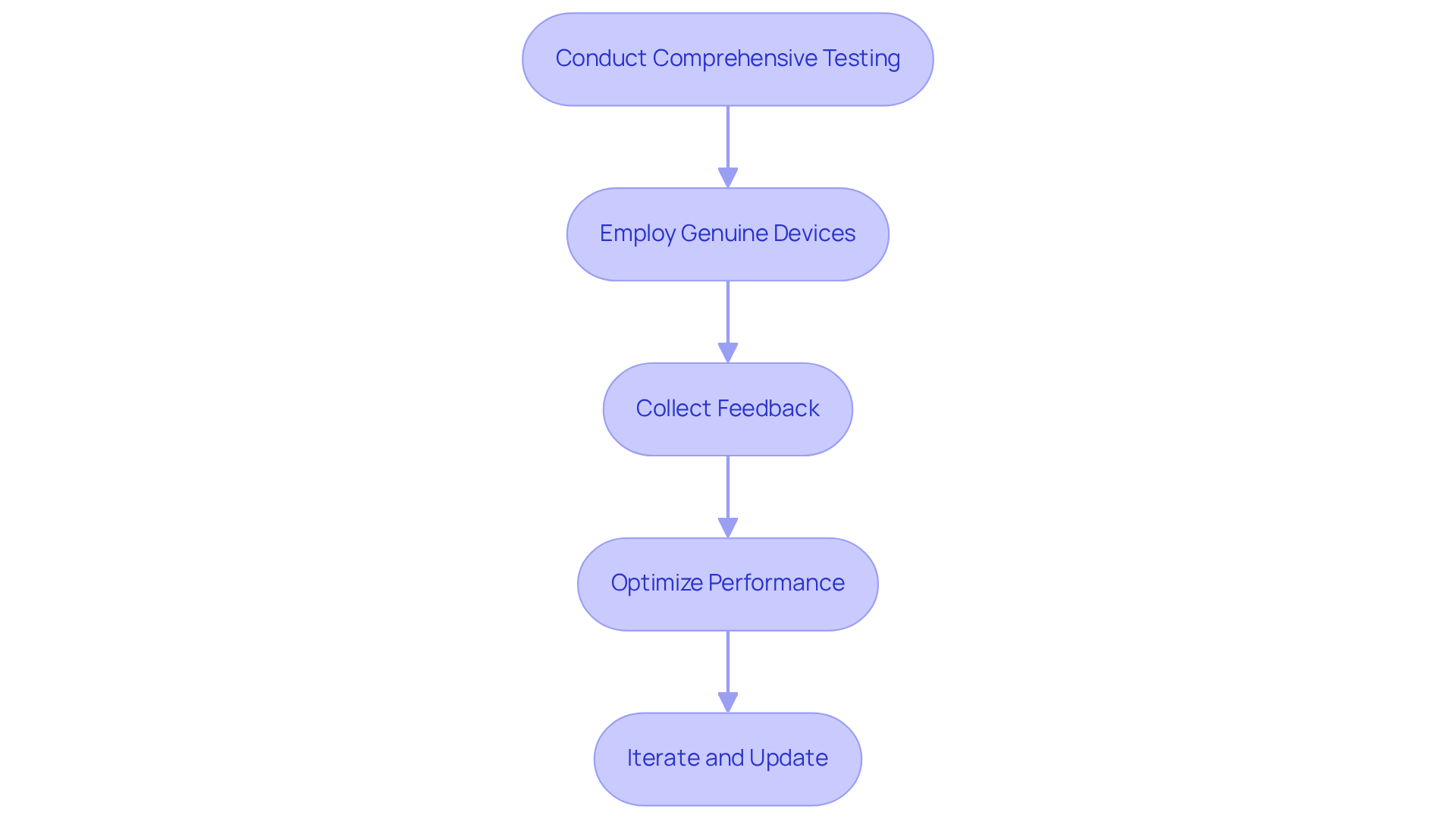Overview
This article delineates four fundamental practices that are indispensable for effective augmented reality (AR) development in e-commerce. These practices encompass:
- Core skills
- User-centric design
- Interactive features
- Robust testing strategies
Mastering 3D modeling, programming, and UX design is essential, alongside the incorporation of virtual try-ons and comprehensive testing. Such elements are crucial for crafting engaging AR experiences that not only enhance customer interaction but also drive sales in a fiercely competitive marketplace.
To capture the attention of brand managers, it is vital to recognize that these practices are not merely recommendations; they are proven strategies that have been shown to yield significant results. Research indicates that businesses implementing AR technologies experience increased customer engagement and higher conversion rates.
As you consider the implementation of these practices, remember that collaboration is key. By leveraging expert insights and industry standards, you can transform your e-commerce platform into a leader in AR innovation. The time to act is now—embrace these strategies to elevate your brand's presence and performance in the digital marketplace.
Introduction
The rapid evolution of augmented reality (AR) is fundamentally reshaping the landscape of e-commerce, presenting unprecedented opportunities for brands to engage customers in innovative ways. With the AR market projected to soar to $198 billion by 2025, it becomes essential for companies to understand key practices for effective AR development in order to remain competitive. However, amidst the myriad of technologies and design principles to consider, how can businesses ensure their AR applications not only captivate users but also drive meaningful conversions?
Identify Core Skills and Technologies for AR Development
To effectively develop AR applications for e-commerce, teams must prioritize several core skills and technologies:
-
3D Modeling and Animation: Mastery in creating realistic 3D models is crucial. Tools like Blender and Maya are widely utilized for designing product representations that seamlessly integrate into AR environments. Research indicates that high-quality 3D assets significantly enhance user involvement and satisfaction.
-
Programming Languages: Proficiency in programming languages such as JavaScript, C#, and Swift is essential for developing AR software across various platforms. Knowledge of AR frameworks like ARKit for iOS and ARCore for Android enhances development capabilities, as these frameworks provide the essential tools for creating engaging environments.
-
User Experience (UX) Design: A solid understanding of UX principles is vital to ensure that AR software is intuitive and user-friendly. This includes expertise in interaction design and usability testing, which are essential for improving engagement and minimizing friction in the shopping process.
-
Computer Vision: Understanding computer vision is fundamental for enabling AR systems to identify and interact with real-world objects effectively. This technology facilitates dynamic interactions, enhancing overall user engagement by providing contextual information and visualizations.
-
Hardware Integration: Grasping how to integrate AR applications with various hardware, such as smartphones and AR glasses, is essential for crafting seamless interactions. As AR technology evolves, staying updated on hardware advancements will be crucial for developers.
By cultivating these skills, teams can significantly enhance their capabilities in AR development, leading to more engaging and effective e-commerce interactions. With projections indicating that the AR market will reach $198 billion by 2025, investing in these competencies is not just beneficial but essential for maintaining a competitive edge in the digital landscape.

Design User-Centric AR Experiences for E-commerce
Designing user-centric AR experiences is grounded in several key principles that demand attention and action:
-
Understand Your Audience: Conduct thorough research to identify the preferences and behaviors of your target audience. Utilize surveys, focus groups, and analytics to gather insights that inform your design decisions.
-
Create Intuitive Interfaces: Ensure the AR interface is easy to navigate. By utilizing known gestures and controls, you can significantly reduce the learning curve for users, enhancing their overall experience.
-
Utilize Narrative Techniques: Employ storytelling methods to craft engaging interactions that captivate participants. Craft narratives around products to enhance their appeal and create memorable experiences.
-
Test with Real Individuals: Perform usability testing with genuine participants to collect valuable feedback on the AR interaction. This process is essential for identifying pain points and areas for improvement.
-
Iterate Based on Feedback: Leverage insights obtained from participant testing to continuously enhance the AR interaction. Iteration is crucial to ensuring that the application meets user expectations and remains relevant in a rapidly evolving landscape.
By prioritizing user-centered design, companies can develop AR development interactions that not only captivate customers but also drive conversions, ultimately leading to greater success in the marketplace.

Incorporate Interactive Features to Boost Customer Engagement
To enhance customer engagement through augmented reality (AR), brands must consider incorporating the following interactive features:
-
Virtual Try-Ons: This feature empowers customers to virtually try on products, such as clothing or accessories, using their device's camera. By providing a realistic preview of how items will look, it significantly enhances the shopping experience and increases conversion rates. Magic Playbox has successfully implemented this feature in over 100 high-quality projects since its inception in 2015, demonstrating its effectiveness in driving sales.
-
Interactive Product Demos: Engage customers with demonstrations that allow them to explore product features in detail. This can include rotating 3D models or animations that showcase functionality, enabling customers to interact with products before making a purchase. Industry leaders emphasize that such interactive demos can significantly improve customer understanding and satisfaction.
-
Gamification Elements: Incorporating gamification techniques, such as rewards for completing specific actions or challenges, encourages participant interaction and fosters repeat visits. This approach not only entertains but also drives customer loyalty, as evidenced by various successful implementations in the market.
-
Augmented Reality Navigation: Implement AR navigation tools that assist customers in the shopping process, aiding them in finding products or navigating the store layout effectively. This feature improves customer interaction by streamlining the shopping process, making it more intuitive and enjoyable.
-
Social Sharing Features: Enable users to share their AR experiences on social media platforms. This not only enhances engagement but also serves as organic marketing for the company, broadening reach and visibility. Successful companies have reported heightened customer engagement and awareness through social sharing.
By incorporating these interactive features, companies can create captivating AR experiences that engage users and drive sales. Studies indicate that such enhancements can lead to significant increases in customer interaction and conversion rates. Additionally, it is crucial to be aware of common pitfalls in implementing these features, such as ensuring user-friendly interfaces and providing adequate support to maximize their effectiveness.

Implement Testing and Optimization Strategies for AR Applications
To ensure the success of AR applications, brands must implement effective testing and optimization strategies:
-
Conduct Comprehensive Testing: Testing AR software across a variety of devices and operating systems is essential to guarantee compatibility and performance. This process includes functional, usability, and performance testing to identify potential issues early on.
-
Employ Genuine Devices: Testing AR software on real devices, rather than relying solely on emulators, provides more precise insights into interaction and performance. Real-world testing uncovers device-specific issues that may not be apparent in simulated environments.
-
Collect Feedback: Engaging individuals in the testing process is crucial for obtaining insights into their interactions. This engagement uncovers usability challenges and emphasizes areas for enhancement, ensuring the software meets audience expectations.
-
Optimize Performance: Focus on optimizing AR assets to achieve faster loading times and smoother interactions. Techniques such as reducing polygon counts and employing efficient rendering methods can significantly enhance performance, leading to an improved user experience.
-
Iterate and Update: After launch, consistently tracking the performance of AR software is vital. Utilizing analytics to monitor engagement allows companies to pinpoint areas for further enhancement and implement essential modifications to boost overall effectiveness.
By adopting these testing and optimization strategies, brands can ensure their AR development delivers a seamless and engaging user experience, ultimately driving customer satisfaction and loyalty.

Conclusion
Investing in augmented reality (AR) development is imperative for e-commerce brands seeking to elevate customer engagement and drive sales. By honing core skills such as:
- 3D modeling
- programming
- user experience design
- computer vision
- hardware integration
teams can develop compelling AR applications that resonate with consumers. These foundational competencies not only enhance product representation but also cultivate an intuitive shopping experience that aligns with the evolving demands of the digital marketplace.
Throughout this article, several key practices have been underscored, including the critical importance of:
- designing user-centric experiences
- incorporating interactive features like virtual try-ons and gamification
- implementing robust testing and optimization strategies
Collectively, these elements create immersive and engaging AR interactions that not only captivate users but also enrich their overall shopping journey. By prioritizing these strategies, brands can ensure their AR applications are not only functional but also enjoyable and effective.
Ultimately, the future of e-commerce hinges on the ability to leverage innovative technologies like AR to craft memorable shopping experiences. As the AR market continues to expand, brands must remain proactive by adopting best practices and continuously refining their approaches. Embracing these strategies will not only enhance customer satisfaction but also position businesses for success in a competitive landscape, paving the way for a more interactive and engaging shopping experience in the years to come.
Frequently Asked Questions
What are the core skills needed for AR development in e-commerce?
The core skills needed for AR development in e-commerce include 3D modeling and animation, proficiency in programming languages, user experience (UX) design, computer vision, and hardware integration.
Why is 3D modeling and animation important in AR development?
Mastery in creating realistic 3D models is crucial as high-quality 3D assets significantly enhance user involvement and satisfaction in AR environments.
Which programming languages are essential for developing AR applications?
Essential programming languages for AR development include JavaScript, C#, and Swift. Knowledge of AR frameworks like ARKit for iOS and ARCore for Android is also important.
How does user experience (UX) design contribute to AR applications?
A solid understanding of UX principles ensures that AR software is intuitive and user-friendly, improving engagement and minimizing friction in the shopping process.
What role does computer vision play in AR development?
Understanding computer vision is fundamental for enabling AR systems to identify and interact with real-world objects effectively, enhancing user engagement by providing contextual information and visualizations.
Why is hardware integration important in AR development?
Grasping how to integrate AR applications with various hardware, such as smartphones and AR glasses, is essential for creating seamless interactions as AR technology evolves.
What is the projected growth of the AR market, and why is this significant for developers?
The AR market is projected to reach $198 billion by 2025, making it essential for developers to invest in core AR competencies to maintain a competitive edge in the digital landscape.




